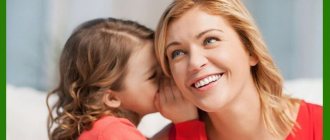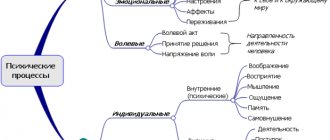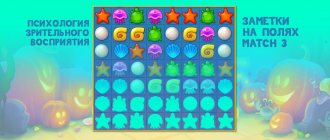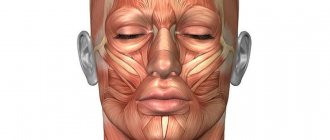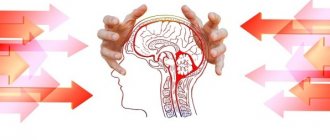What are cognitive functions?
Cognitive (cognitive) functions are complex functions of the main organ of the central nervous system - the brain. With their help, a person not only learns about the world around him, but also actively interacts with it.
Cognitive functions are divided into 6 cognitive abilities:
- thinking;
- speech;
- attention;
- memory;
- gnosis (orientation in space, as well as recognition of time and place);
- praxis (purposeful motor activity).
Thanks to cognitive functions, a person’s personality is formed, and his abilities for education, work and other areas of life are determined.
Interacting components of cognitive functions
Human cognitive abilities - what is it?
Being in society, a person develops and is formed as a personality. He begins to perceive his own person as an individual “I”. Self-awareness gradually develops, social and moral foundations are built.
Human cognitive development
Note! Thanks to cognitive functions, an individual gets an idea of his appearance, significance in society, and draws conclusions about his abilities. The image of “I” is gradually filled.
Psychologists and psychiatrists identify 4 main interacting components of human cognitive abilities. Each of them is closely associated with a specific cognitive function.
Relationship between cognitive functions and basic components
| Interacting Components | Link to Cognition |
| Perception of information | It is carried out through taste, smell, tactile gnosis, auditory and visual apparatus. |
| Processing and analysis of received information | “Executive” functions are involved, which include generalization, voluntary attention, detection of differences and similarities, establishment of associative connections, construction of logical connections and conclusions. Intelligence and thinking help to adapt to the world around us, calmly react to a constantly changing environment, and adjust one’s behavior depending on current situations. |
| Memorization and subsequent storage of analyzed information | The component is inextricably linked with memory and learning ability. |
| Exchange of information, planning, and subsequent implementation of planned actions | “Expressive functions” are involved, which include praxis and speech. |
How to write a term paper on speech therapy
07.09.2010 179902
These guidelines are compiled to help students gain an understanding of the content and structure of coursework in speech therapy.
Logopedia of pedagogical science that studies anomalies of speech development with normal hearing, explores the manifestations, nature and mechanisms of speech disorders, develops the scientific basis for overcoming and preventing them means of special training and education.
The subject of speech therapy as a science is speech disorders and the process of training and education of persons with speech disorders.
The object of study is a person suffering from a speech disorder.
The main task of speech therapy as a science is the study, prevention and elimination of various types of speech disorders.
Coursework in speech therapy is a student's scientific and experimental research. This type of educational activity, provided for by the educational and professional program and curriculum, contributes to the acquisition of skills in working with literature, analyzing and summarizing literary sources in order to determine the range of insufficiently studied problems, determining the content and methods of experimental research, processing skills and qualitative analysis of the results obtained. The need to complete coursework in speech therapy is due to the updating of knowledge concerning the content, organization, principles, methods and techniques of speech therapy work.
As a rule, during their studies, students must write two term papers - theoretical and practical.
The first course work should be devoted to the analysis and synthesis of general and specialized literature on the chosen topic. Based on this analysis, it is necessary to justify and develop a method of ascertaining (diagnostic) experiment.
In the second course work, it is necessary to provide an analysis of the results obtained during the ascertaining experiment, as well as determine the directions and content of speech therapy work, and select adequate methods and techniques of correction.
So, let’s present the general requirements for the content and design of coursework in speech therapy.
The initial and most important stage of working on a course project is the choice of a topic, which is either proposed by the supervisor or chosen by the student independently from a list of topics that are consistent with the areas of scientific research of the department.
Each topic can be modified, considered in different aspects, but taking into account a theoretical and practical approach. Having chosen a topic, the student needs to think through in detail its specific content, areas of work, practical material, etc., which should be reflected both in the formulation of the topic and in the further construction of the study. It should be recalled that the chosen topic may not only have a purely theoretical orientation, for example: “Dysarthria. Characteristics of the defect”, “Classification of dysgraphia”, but also take into account the practical significance of the problem under consideration, for example: “Speech therapy work on speech correction for dysarthria”. It should also be taken into account that when formulating a topic, excessive detail should be avoided, for example: “Formation of prosodic components of speech in preschoolers of the sixth year of life attending a preschool institution for children with severe speech impairments.”
The course work includes such mandatory parts as: introduction, three chapters, conclusion, bibliography and appendix.
The text of the term paper begins with the title page . An example of its design can be seen here.
Then the content of the work is given, in which the names of chapters, paragraphs, and sections are formulated in strict accordance with the content of the thesis. An example of its design can be seen here.
In the text, each subsequent chapter and paragraph begins on a new page. At the end of each chapter, the materials are summarized and conclusions are formulated.
The introduction reveals the relevance of the problem under consideration in general and the topic being studied in particular; the problem, subject, object, and purpose of the study are defined. In accordance with the goal and hypothesis, objectives and a set of research methods aimed at achieving the objectives must be defined.
The relevance of the topic lies in reflecting the current level of pedagogical science and practice, meeting the requirements of novelty and usefulness.
When defining the research problem, it is important to indicate what practical tasks it will help to implement in training and educating people with speech pathology.
The object of research is understood as certain aspects of pedagogical reality, perceived through a system of theoretical and practical knowledge. The ultimate goal of any research is to improve this object.
The subject of research is some part, property, element of an object, i.e. the subject of research always indicates a specific aspect of the object that is to be studied and about which the researcher wants to gain new knowledge. An object is a part of an object.
You can give an example of the formulation of the object, subject and problem of research:
– The object of the study is the speech activity of preschool children with phonetic-phonemic speech disorders.
– The subject of the study is the features of intonation speech of children with phonetic-phonemic speech disorders.
– The research problem is to determine effective directions for speech therapy work on the formation of intonation expressiveness of speech in the system of correctional intervention.
The purpose of the study contributes to the specification of the object being studied. The goal of any research is to solve a specific problem. The goal is specified in tasks taking into account the subject of research.
The research objectives are formulated in a certain sequence, which determines the logic of the research. The research objectives are set on the basis of a theoretical analysis of the problem and an assessment of the state of its solution in practice.
The first chapter is an analysis of literary sources, which examines the state of this problem in historical and modern aspects, and presents the most important theoretical principles that formed the basis of the study.
When writing the first chapter, you should pay attention to the fact that the text of the course work must be written in a scientific style. When presenting scientific material, it is necessary to comply with the following requirements:
– Specificity – a review of only those sources that are necessary to disclose only a given topic or solve only a given problem;
– Clarity – which is characterized by semantic coherence and integrity of individual parts of the text;
– Logicality – which provides for a certain structure of presentation of the material;
– Reasoning – evidence of thoughts (why this and not otherwise);
– Precision of wording, excluding ambiguous interpretation of the authors’ statements.
A literary review of the state of the problem being studied should not be reduced to a consistent presentation of literary sources. It should present a generalized description of the literature: highlight the main directions (currents, concepts, points of view), analyze in detail and evaluate the most fundamental works of representatives of these directions.
When writing a work, the student must correctly use literary materials, make references to the authors and sources from which the results of scientific research are borrowed. Failure to provide required references will reduce your coursework grade.
As a rule, in coursework on speech therapy, references to literary sources are formatted as follows: the number of the cited source in the general list of references is placed in square brackets. For example: General speech underdevelopment is a speech pathology in which there is a persistent lag in the formation of all components of the language system: phonetics, vocabulary and grammar [17].
When using quotations, in square brackets, in addition to indicating the source number, the page number from which this excerpt is taken is indicated, for example: Speech rhythm is based on a physiological and intellectual basis, since, firstly, it is directly related to the rhythm of breathing. Secondly, being an element that performs a communicative function, “correlates with meaning, i.e. controlled intellectually” [23, P.40].
However, course work should not be of a purely abstract nature, so you should not abuse the unreasonable abundance of citations. Quoting should be logically justified, convincing and used only when really necessary.
In the second chapter , devoted to experimental research, the organization should be described and the program of the ascertaining experiment should be presented. The survey methodology, as a rule, consists of a description of several series of tasks, with detailed instructions, visual and lexical material, the procedure for completing tasks by experiment participants, and scoring criteria. This chapter also provides a qualitative and quantitative analysis of the results obtained.
When analyzing the results of an experiment, it is necessary to use a scoring system. Examples of various criteria for quantitative and qualitative assessment are presented in the following works:
– Glukhov V.P. Formation of coherent speech in preschool children with general speech underdevelopment. - M.: Arkti, 2002. - 144 p.
– Fotekova T.A. Test methodology for diagnosing oral speech of primary schoolchildren. - M.: Arkti, 2000. - 56 p.
– Levchenko I.Yu. Pathopsychology: Theory and practice. - M.: Academy, 2000. - 232 p.
In order to visually present the results obtained during the experimental study, it is recommended to use tables, graphs, diagrams, etc. Histograms can be used in a variety of ways - columnar, cylindrical, planar, volumetric, etc. An example of the design of tables, figures, and histograms can be found here.
The third chapter provides a rationale for the proposed methods and techniques and reveals the content of the main stages of correctional work.
The conclusion contains a summary of the material presented and the main conclusions formulated by the author.
The bibliography must contain at least 25 sources. The list includes bibliographic information about the sources used in preparing the work. An example of its design can be seen here.
In the application you can present bulky tables or illustrations, examination protocols, observation records, products of activity (drawings, written works of children), notes from speech therapy classes, etc.
The volume of one course work must be at least 30 pages of typewritten text.
In general, coursework in speech therapy is the basis for a future thesis, in which the study of the begun problem can be continued, but from the standpoint of a different approach or a comparative analysis of the disorders being studied in different age categories of people with different types of speech disorders.
The content and format of theses in speech therapy can be found here.
Literature:
1. How to write a term paper on speech therapy: Methodological recommendations. Educational and methodological manual / Comp. Artemova E.E., Tishina L.A. / Ed. Orlova O.S. – M.: MGOPU, 2008. – 35 p.
2. Research work of students in the system of higher professional pedagogical education (specialty 031800 - Speech therapy). Methodological recommendations for completing the thesis / Compiled by. L.V. Lopatina, V.I. Lipakova, G.G. Golubeva. - St. Petersburg: Publishing house of the Russian State Pedagogical University named after. A. I. Herzen, 2002. - 140 p.
How a child’s cognitive functions develop
Human resource management - what it is, principles and functions of the process
The development of cognitive functions in humans occurs throughout life. Everything a child does during the first years after birth is the foundation for the subsequent formation of cognitive abilities:
- Thanks to curious questions “why?”, the baby’s thinking gradually develops. The peak search for answers occurs at the age of 3-5 years.
- Play activities develop children’s attention, as well as the ability to build interpersonal communications. Younger preschoolers actively develop an involuntary interest in attractive objects, people or events, while older preschoolers can intently observe anything.
- By the age of 6-7 years, voluntary memorization and recall are formed. The child can reproduce the named objects and combine them by meaning.
- During childhood, children develop their imagination. The first formation occurs in play or creativity.
- The more experience a child accumulates, the more actively the child’s perception develops.
- Gradually, children accumulate vocabulary. At preschool age, the child begins to become aware of his own pronunciation. By the age of 3-5 years, the baby is able to learn “adult” words.
According to child psychology, the formation of all basic perception skills occurs at 6-7 years of age.
Stages of child cognitive development
When a child goes to school, he already knows how to speak, he has the ability to learn. In an educational institution he develops:
- verbal-logical thinking;
- verbal and figurative memory;
- written speech.
The development of analytical functions occurs by the age of 12-15. Their improvement occurs throughout life.
Cognitive function in adults
Functions of communication in psychology and their brief description
Active brain development occurs until the age of 21. With age, the capabilities of mobile intelligence decrease. It becomes difficult for a person to think logically and solve new problems.
Important! Content intelligence, which is responsible for using accumulated experience, on the contrary, is growing rapidly.
A person's mental abilities practically do not decline with age, but cognitive processing of information occurs more slowly, and it becomes more difficult to remember the necessary information.
Functions and structure
Functions:
- Reception, processing of sensory information that comes from the outside world.
- Rough processing of primary data, drawing up a general idea of a specific topic.
- Saving the received information and distributing it across different memory blocks.
- Creation of abstract concepts.
- Establishing relationships between blocks of information.
- Creation of promising tasks.
- Formation of strategies for different types of activities.
One of the functions for which cognitive processes are responsible is prognostic. With its help, a person calculates what the result will be after performing a certain type of activity.
Structure of cognitive processes:
- Obtaining information.
- Data processing at the primary level.
- Generalization, synthesis, analysis, comparison.
- Saving information.
- Creation of new images, concepts, knowledge.
- Carrying out complex operations with acquired information.
Human cognition has a hierarchy that consists of complex, simple levels of cognitive processes.
Cognitive function in older people
According to statistics, from 3 to 20% of older people over 65 years of age experience severe cognitive impairment in the form of dementia.
Additional Information. Translated from Latin, dementos means “loss of reason.”
Emerging cognitive problems disrupt the usual rhythm of life. It becomes difficult for an elderly person to take part in social, professional and everyday activities. Some grandparents may lose some of their autonomy and independence.
Signs of dementia in older people
Advice. If an older person develops cognitive problems, the first thing to do is see a doctor.
Cognitive processes
Cognitive processes are mental processes that ensure the receipt, storage and reproduction of information and knowledge from the environment.
We can say that when they talk about abilities, talent, genius, intelligence and level of development, they mean, first of all, cognitive processes. A person is born with these inclinations, but at the beginning of life he uses them unconsciously; later their formation occurs. If he learns to use them correctly, and most importantly, to develop them, he will be able to achieve the most ambitious goals.
There are different classifications of cognitive processes, most often there are eight of them. Brief description of them:
- Memory : This is the system of remembering, forgetting and recalling experiences over time. In the psychology of cognitive processes, memory ensures the integrity of the individual.
- Attention : this is the selective direction of perception towards something. At the same time, attention is not considered a separate cognitive process, but rather a property of the others.
- Perception : sensory knowledge of objects in the surrounding world, subjectively appearing direct, immediate. It is very closely related to sensations, through which information is received by the brain and is material for processing, evaluation and interpretation by perception.
- Thinking : this is the ability to obtain certain knowledge about phenomena that cannot be perceived through other cognitive processes. It can be verbal-logical, visual-entrepreneurial, practical, visual-figurative.
- Imagination : a person’s ability to spontaneously arise or deliberately construct images, ideas, ideas of objects in the mind. It is the basis of visual-figurative thinking.
- Speech : a process of communication that occurs through language. A person is capable of perceiving and accepting linguistic structures, creating and reproducing his thoughts using language.
- Representation : the ability to reflect in consciousness the quality of various objects. There are speech, phonetic, auditory, intonation, musical and visual representations.
- Sensations : a person’s ability to feel specific phenomena and objects around him. Our consciousness, one might say, exists only thanks to them. There are gustatory, visual, olfactory, auditory and tactile sensations (however, some scientists believe that these are only basic; there are also additional ones). Information obtained through sensations (sense organs) is transmitted to the brain and perception comes into play.
On our website you can find a lot of materials devoted to the theory and training of various cognitive processes:
- A course on memory development (also develops attention).
- Creative thinking course (trains imagination, memory and presentation).
- Cognitive science (trains thinking).
Diagnostics of cognitive processes in adults and children
In psychiatry, there are a huge number of tests and techniques that diagnose cognitive processes.
Children's tests can be divided by age:
- From 3 to 6.
- From 7 to 16.
Tests for schoolchildren from 3 to 6 years old:
- “Cut out the shapes.” For psychodiagnostics of visual-effective thinking.
- “Remember and dot the points.” Attention span.
- “Who lacks what?” For psychodiagnostics of children's thinking.
- "Find the sound." To test phonemic hearing.
- "Divide into groups." To diagnose figurative-logical thinking.
Tests for children from 7 to 16 years old:
- "20 words." To assess the development of memorization techniques.
- "Comparison of Concepts". To assess the ability to carry out analytical and synthetic activities.
Tests for adults:
- "Anagrams - 2011. Form A." To identify the level of fluency of abstract logical thinking and combinatorial abilities.
- “Learning words according to A. R. Luria.” To study memory processes.
- "Quantitative Relations". To assess logical thinking.
- "Munstenberg test". Noise immunity and selectivity of attention.
Whatever the level of your cognitive processes, you must train them, and ideally this should be done constantly.
Let's focus on each cognitive process and find out what games and exercises there are to develop it. Of course, it is impossible to fully cover the topic in the space of a blog article, so this is just basic information.
1
Memory
Exercise one : memorizing words.
Read the following list: drum, chair, carpet, letter, cork, tool, pan, picture, vase, pin, bag. Take 30 seconds to memorize them. Don't try to use mnemonics.
Exercise two : remember yesterday.
Our memory deteriorates because we very rarely try to remember past events and do not keep a diary. So sit in a quiet place and try to recreate yesterday in the smallest detail.
Exercise three : kitchen.
Right now, try to remember what your kitchen (or any other room you know well) looks like in detail.
2
Attention
Exercise one : Stroop test.
Look at the picture and name the colors in which each word is written.
Exercise two : radio.
Play a song that has a lot of words. After 10 seconds, begin to gradually reduce the volume. Set the lowest limit at which you can still understand what is being said. Start listening to this song again. This exercise will allow you to focus only on her.
Exercise three : observation.
Find an image of an unknown painting on the Internet. Look at it for one minute. Close your eyes and try to reproduce it exactly. Open your eyes and compare the results.
3
Perception
Exercise : overcoming noise (selectivity of perception).
This exercise will require at least four people to participate. The members of each pair are placed from each other at the maximum possible distance (in the corners of the room). After that, everyone starts talking at the same time. The task of each participant is to carry on a dialogue with his partner, despite the noise.
4
Thinking
Exercise one : brain box.
Choose any three topics. This could be the plot of a recently watched film, an idea, news. Now start thinking about the first topic for three minutes. When finished, move on to the second topic, then to the third.
Exercise two : find the reason.
The exercise must be done in company. One person performs an action for a reason known only to him, and the second participant must guess it. And so on until all the motives for the behavior of the first participant are clarified.
5
Imagination
Exercise one : random words.
Pick ten random words from a book or magazine. Link them together to make a short story, interspersing them with other words.
Exercise two : idea from chaos.
Take a sheet of paper and randomly place several dots on it. Connect them with lines. What associations does the figure evoke? What does she look like? The same game can be played by two people. One draws, the other guesses and vice versa.
6
Speech
These exercises are suitable for children from 2 to 6 years old.
Exercise one : words starting with a specific letter.
Ask your child to name as many words as possible that start with a specific letter.
Exercise two : searching for verbs.
Choose nouns for your child ("house", "road", "car") and let him choose verbs for them. For example, a car drives, brakes, turns, stops, accelerates.
Exercise three : retelling what you read.
Choose a story that is likely to interest your child. Read it. Now invite him to retell the text, ask clarifying questions.
7
Performance
To form and develop spatial understanding, we recommend that you collect puzzles and play with Lego as much as possible. This activity is useful for both a child and not shameful for an adult.
8
Feel
Exercise one : observing a tree (visual sensations).
Look out the window and watch a tree or any other large object. Appreciate its height, beauty, colors. Compare with other trees.
Exercise two : comparing sounds.
Go out onto the balcony again and listen to the sounds. Choose the two that are the most intense and loud. Start comparing.
Exercise three : taste sensations.
If you have two types of cheese or other product, cut it into small pieces and try one at a time. What is the difference? Find 5 differences.
We wish you good luck!
Did you like the article? Join our communities on social networks or our Telegram channel and don’t miss the release of new useful materials: TelegramVKontakteFacebook
We also recommend reading:
- Storytelling
- Development of thinking: ways to train the brain
- Mental processes: types and brief description
- Cognitive sphere of personality
- Neuroplasticity
- How to develop a child's thinking
- Cognitive psychology and cognitive psychotherapy
- Cattell-Horn-Carroll theory
- Intelligence and its development: several recommendations
- Two important laws of memory
- Sapir-Whorf hypothesis
Key words: _D1002, _D1003, _D1026, _D1027, 1Mnemotechnics, 4Cognitive science
Causes of cognitive impairment
To help a person treat cognitive problems, you need to know what caused this illness, because the result depends on the correct diagnosis. Cognitive impairment can develop at any age with various somatic, mental and neurological diseases. Among the main reasons are:
- Alzheimer's disease;
- vascular diseases of the brain (cerebral ischemia, cerebral infarction);
- Parkinson's disease;
- a brain tumor;
- traumatic brain injury;
- demyelinating diseases and neuroinfections (HIV, multiple sclerosis, Creutzfeldt-Jakob disease, progressive panencephalitis);
- overwork, negative emotions and depression;
- dysmetabolic encephalopathies (domestic and industrial intoxication, deficiency of proteins, B vitamins and folic acid, renal and liver failure, iatrogenic cognitive impairment).
If a person has chronic degenerative and vascular diseases of the brain, then it is almost impossible to overcome cognitive impairment. In any other case, timely correction will help correct the situation. The duo of cognitive functioning and medications can be used to achieve this.
Additional Information. Cognitive functioning is a set of activities that will help “activate” and improve cognitive functions.
This includes the following list of simple activities:
- learning foreign languages;
- development of new routes and territories;
- playing musical instruments;
- development of positive thinking;
- yoga, dancing or strength training.
Iatrogenic disorders
Often, cognitive impairment is directly related to taking a large amount of medications and their side effects.
What is iatrogeny
Important! About 5% of dementias develop due to iatrogenic causes.
The following medications have an adverse effect on cognitive function:
- neuroleptics;
- diuretics;
- antidepressants;
- products with bromine;
- opiates;
- cosmetics with bismuth;
- antifungal antibiotics;
- drugs against tumors;
- sedatives.
Also, the development of iatrogenic disorders can occur due to radiation therapy, which is carried out in the fight against malignant tumors in the body. Any drugs that have an effect on neuronal function or overall homeostasis should be primarily considered as a major cause of cognitive impairment.
To protect yourself and your loved ones from a decline in memory, thinking, attention and other abilities, you need to eat right, walk more in the fresh air, train cognitive skills, engage in active sports and not take any medications without first consulting a specialist.


